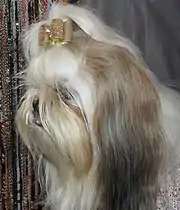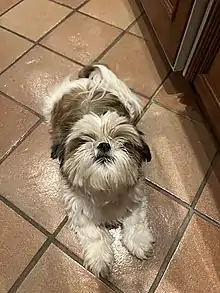Shih Tzu
The Shih Tzu (UK: /ˌʃiːˈtsuː/, US: /ˈʃiːtsuː/;[1] Chinese: 西施犬; pinyin: Xī Shī quǎn literally "Hsi Shih dog") is a toy dog or pet dog breed originating from Tibet and believed to be bred from the Pekingese and the Lhasa Apso.
| Shih Tzu | |||||||||||||||||||||||||||||||
|---|---|---|---|---|---|---|---|---|---|---|---|---|---|---|---|---|---|---|---|---|---|---|---|---|---|---|---|---|---|---|---|
.jpg.webp) A Shih Tzu in full show coat | |||||||||||||||||||||||||||||||
| Other names | Chrysanthemum Dog | ||||||||||||||||||||||||||||||
| Origin | Tibet | ||||||||||||||||||||||||||||||
| |||||||||||||||||||||||||||||||
| |||||||||||||||||||||||||||||||
| Dog (domestic dog) | |||||||||||||||||||||||||||||||
| Shih Tzu | |||||
| Tibetan name | |||||
|---|---|---|---|---|---|
| Tibetan | |||||
| |||||
Shih Tzus are known for their short snouts and large round eyes, as well as their long coat, floppy ears, and short and stout posture. They are well known for their playful personality and their calm and friendly temperament, and sometimes may bark at newcomers .[2]
They can adapt well to different situations. Due to their highly independent nature, they are not considered as a very obedient breed.[3]
Description
[[File:Shih-Tzu.jpg|thumb|153x153px|A Tricolor (black, white, brown) Shih Tzu
in s 2007">Juliette., Cunliffe (2007). Shih tzu. Kennel Club Books. ISBN 978-1-59378-216-0. OCLC 232358683. Archived from the original on 1 May 2021. Retrieved 11 March 2021.</ref> They have a soft and long double coat that will tangle and mat easily if not brushed at least every 2 or 3 days. A Shih Tzu should stand no more than 26.7 cm (101⁄2") at the withers and with an ideal weight of 4.0 to 7.5kg (9 to 17 lb). Their floppy ears are covered with long fur, and their heavily fur-covered tail is carried curled over the back. The coat may be of any colour, though white and with blazes of grey are frequently seen. A very noticeable feature is the underbite, which is required in the breed standard.[4]
Because of their long coat and fast-growing hair, regular grooming is necessary, which may be expensive. The traditional long silky coat, which tends to reach the floor, requires daily brushing to avoid tangles. The coat can be clipped short to simplify care, but still requires frequent brushing. For showing, the coat must be left in its natural state, though trimming for neatness around the feet and anus is allowed. The shorter cut is typically called a "puppy cut"[5] or a "teddy bear cut" when the puppy cut is accompanied by a fuller, rounder face, resembling a stuffed animal.
Etymology
The name comes from the Chinese language word for "lion" because this kind of dog was bred to resemble "the lion, as in traditional oriental art".[6] (The Pekingese breed is also called 獅子狗, "lion dog", in Chinese.) The name Shih Tzu is the Wade-Giles romanization of the Chinese characters 獅子 ("lion").


In contemporary Mandarin, the Shih Tzu is generally known as the "Xi Shi dog"; Xi Shi was regarded as one of the most beautiful women of ancient China. Shih Tzu was nicknamed the "chrysanthemum dog" in England in the 1930s.[7] The dog may also be called the Tibetan Lion Dog, but whether the breed should be referred to as "Tibetan" or "Chinese" is a source of both historical and political contention. A book on the breed states that "dog historians tend to have very strong opinions" on the subject.[8]
History
One theory is that the Shih Tzu descended from a cross between the Pekingese and Lhasa Apso.[9] The dogs were favorites of the Chinese royals and so prized that, for years, the Chinese refused to sell, trade, or give any away. The first dogs of the breed were imported into Europe (England and Norway) in 1930 and were classified by the Kennel Club as "Apsos".[9] The first European standard for the breed was written in England in 1935 by the Shih Tzu Club,[10] and the dogs were categorised again as Shih Tzu. The breed spread throughout Europe and was brought to the United States after World War II, when returning members of the U.S. military brought back dogs from Europe and Asia, in the mid-1950s. The Shih Tzu was recognized by the American Kennel Club in 1969 in the Toy Group.[9] There are fourteen total iterations of the Shih Tzu in the breed's gene pool today.[11] In 1934, the Shih Tzu Club of England was founded[12] and the breed was officially recognised by the Kennel Club (UK) on 7 May 1940. When it became eligible for Challenge Certificates, none were awarded until 1949. The breed is now recognized by all of the major kennel clubs in the English-speaking world.[4] It is also recognized by the Fédération Cynologique Internationale for international competition in Companion and Toy Dog Group, Section 5, Tibetan breeds.[4] In the United States, the Shih Tzus were ranked the 15th most popular breed in 2013, falling slightly in popularity since 2012 when it was placed in 11th position.[13]In Israel the Shih Tzus were ranked as the most popular breed in 2019.[14]
_02.jpg.webp)
Shih Tzus and Buddhist mythology
Shih Tzus are largely associated with Buddhism and Buddhist mythology. The name "Shih Tzu" in Mandarin directly translates to "little lion," an animal considered sacred in Buddhist religion. Lions symbolize royalty, strength, and bravery – "fear nothing, and act without delay."[15] Pairs of stone lions or lion dogs located outside guard palace doors, tombs, temples, and public buildings are thought to protect these buildings from harmful individuals and spiritual influences.[15] These stone statues are often called Fu (or Foo) dogs, and it is suggested that these are the lionized form of the Shih Tzu.[16] "Fu" roughly translates to "happiness" in Manchurian, with legend stating Fu dogs are happy Shih Tzus forever guarding the temple of Buddha.[16] Fu dog statues typically represent a male and female Shih Tzu, carved out of stone, jade, teak, ivory, cinnabar, bronze, or ceramics.[17] The male dog is often seen holding a ball with his left paw and the female dog holds her puppy. Sources state this holds a symbolic meaning, with the male dog representing powers over nature, energy, wisdom, and precious stones and the female dog symbolizing protection, play, and a disciplinary attitude.[17]

Buddhists consider Shih Tzus blessed by and sacred beasts of Buddha. Legend states Buddha rode to earth on a lion and carried with him a small lion dog which accompanied him everywhere he went.[16] Legends vary across different sources, however many cite the Shih Tzu accompanied the Buddha of wisdom, Manjushri.[17] This lion dog had the ability to turn himself into a lion to carry Manjushri on his back. The physical features of Shih Tzus serve as proof of the eternal connection between Buddha and this breed. According to legend, several robbers surrounded Buddha with the intention of robbing and murdering him when the Shih Tzu transformed into a ferocious lion so large that the robbers were scared and fled the scene.[16] As the Shih Tzu returned to its dog form, Buddha blessed him for his courage.[16] Many Shih Tzus reflect this blessing in the form of the "Star of Buddha", which may also be called "Buddha's kiss", represented as a white patch of hair on the top of dog's head. Markings on the dogs back is said to be the saddle Buddha used to ride the dog in its lion form.[18] Legends vary across sources, largely because legends are historically passed down by word-of-mouth. Some cite this mark on the head as the place where Buddha kissed the dog, giving it his blessing.[18] Other sources state Buddha laid his finger on the dog's forehead in blessing, giving it a flash of white hair on its forehead.[16]
Coat colors
The Shih Tzu is a small breed of dog with a wide range of coat colors, from black to gold. Standard recognized Shih Tzu colors include black, blue, red, brindle, liver, silver, and gold. Other color variations may also be available like Albino and White,[19] though they may not be recognized by the American Kennel Club. In addition to solid colors, certain breeders are breeding tonal variations in each of these color types such as lighter or darker shades.
Health
A number of health issues, some of them hereditary, have been found in individual Shih Tzu, and are listed below. The popularity of the breed has allowed for extremely poor breeding in general, leading to generalized and lifelong diseases, often from a fairly early age.
Heart disease
Shih Tzus are prone to multiple types of heart disease. The condition may have a poor prognosis depending on when it is diagnosed and the stage of the disease when it is discovered.
Brachycephaly

Due to the ideal of beauty regarding the shape of the face the skull malformation brachycephaly was increased by breeding selection. This short nose causes problems like skin sensitivities such as dermatitis, bumps, and rashes.[20]
Eye issues
It is very common for Shih Tzus to develop eye problems at any age, and even more so once they are older. Most veterinarians will recommend eye drops to assist with any eye irritations. Some dogs have allergies which cause excess discharge around the eye. Older Shih Tzu are known to develop cataracts which can be corrected with surgery. If not treated, the dog may become blind in the eye that has the cataract. The distinctive large eyes can easily be scratched which may cause an ulcer. The dog will normally have the injured eye closed or half closed and may have excessive tears. The most common problem of Shih Tzus concerning eye conditions is the formation of epiphora caused by the fur on the eyelids scratching the conjunctiva and the cornea. However this can be medicated by the application of prescribed eye drops from a certified veterinarian such as eyevita.[21]Shih Tzus are also prone to excessive tear production which in turn cause tear stains around the eyes.[22]
Hair issues

Shih Tzus do not have fur and have hair which can grow lengthy. Long hair is required as a show coat and is required generally to be brushed or groomed once a day. Hair longer than a puppy cut often causes issues, including hair covering the eyes of the dog, preventing good visual acuity.[23]
Ear issues
A very common issue for Shih Tzus is the development of ear infections, as they have a long coat and hair grows in their ears. If ears are not plucked and cleaned often, ear infections will reoccur and need to be treated with ear cleaner and possibly medication, prescribed by the veterinarian. Ear infections may be spotted by an odor coming from the ears, as well as frequent shaking of the head and scratching of the ears.[24]
Skin sensitivities
The Shih Tzu's skin is particularly sensitive and prone to allergies. They should ideally be bathed every two to six days to maintain hygiene and prevent skin irritations.
Stomach issues
Shih Tzu dogs are prone to stomach and digestive system issues, and most have delicate appetites.[25]

Lifespan
The UK Kennel Club survey puts the median lifespan of a Shih Tzu at 10 to 16 years.[26] The oldest recorded Shih Tzu lived to 23 years of age.[27]
The oldest living Shih Tzu as of 2021 is Tutsy, born in September, 2003 in Liverpool, England.[28]
Breeding
The Shih Tzu will have 3 to 4 puppies at one time on average. Older Shih Tzus will tend to have more puppies per litter. 20% of Shih Tzus give birth via C-section.[29] Young female Shih Tzus will go into their first heat around six months old, repeating the process twice a year unless they are spayed. Traditionally, the breeding process for a Shih Tzu is complicated and time-consuming.[30] The process required constant attention from the owner during the entirety of pregnancy, birth, and the tending of the litter. A pregnant Shih Tzu's stomach can be used to feel for movement as early as 20 days into pregnancy.
Variations
Kennel club differences
There is a difference between the Shih Tzu of the American Kennel Club and the Kennel Club (UK):
The AKC (American Kennel Club) Shih-Tzu
- Their front legs (forequarters) are straight. Their hindquarters are muscular. Neither should be too short nor too long.
- The standard head is big and round and is set high with face looking forward or up.
- The neck and body are the most important and should not be exaggerated.
- The eyes are large and face the front.
- The shoulders of the American type of Shih-Tzu are frontal.[31]
In popular culture
- The design of the video game character Isabelle from the popular video game franchise Animal Crossing is based on the features of a Shih Tzu, as well as her original name in Japanese, Shizue (しずえ), seemingly being based on the name of the dog breed. She has appeared in most Animal Crossing games since the release of Animal Crossing: New Leaf, and is prominently featured in marketing for the franchise.
References
- Upton, Clive; Kretzschmar, William A. Jr. (2017). The Routledge Dictionary of Pronunciation for Current English (2nd ed.). Routledge. p. 1231. ISBN 978-1-138-12566-7.
- "Shih Tzu Dog Breed Information, Pictures, Characteristics & Facts". DogTime. Retrieved 30 October 2022.
- "Shih Tzu". www.petmd.com. Retrieved 30 October 2022.
- "Federation Cynologique Internationale Breed Standard" (PDF). Fci.be. Archived (PDF) from the original on 31 October 2017. Retrieved 11 December 2017.
- "United Kennel Club: Shih Tzu". United Kennel Club. 1 May 2007. Archived from the original on 4 June 2011. Retrieved 30 May 2011.
- Shih Tzu, by Jaime J. Sucher, p. 5, Barron's Educational Series, 2000, ISBN 0-7641-1043-8
- Shih Tzu For Dummies, by Eve Adamson, p. 257, For Dummies, Publisher, 2007, ISBN 0-470-08945-8 quote: "Lady Brownrigg, who brought the first Shih Tzu into England, coined the phrase Chrysanthemum Dog."
- Shih Tzu For Dummies, by Eve Adamson, p. 27, For Dummies, Publisher, 2007, ISBN 0-470-08945-8 quote: "...dogs related to the modern-day Shih Tzu probably came from Tibet, but how long they were there and how much influence they had on the present day Shih Tzu may never be known." The author then says, "Dog historians tend to have very strong opinions." It is often mistakenly said that the Shih Tzu is Chinese royalty.
- Clark, Anne Rogers; Andrew H. Brace (1995). The International Encyclopedia of Dogs. Howell Book House. pp. 416–417. ISBN 0-87605-624-9.
- The Shih Tzu, by Audrey Dadds, p. 29, Howell Book House, 1975, ISBN 0-87605-309-6
- "Shih Tzu", Definitions, Qeios, 7 February 2020, doi:10.32388/bookqq, S2CID 241657460
- "The Kennel Club". Archived from the original on 27 November 2016. Retrieved 26 November 2016.
- American Kennel Club 2013 Dog Registration Statistics Historical Comparisons & Notable Trends Archived 17 January 2017 at the Wayback Machine, The American Kennel Club, Retrieved 30 April 2014
- "dog ownership data in Israel, government data".
- "History of the Shih Tzu Dog Breed". Everything Shih Tzu. Retrieved 24 February 2022.
- "Shih Tzu Legends". nationalpurebreddogday.com. National Purebred Dog Day. 26 April 2019. Retrieved 24 February 2022.
- Jorgensen, Anthony. "Shih Tzu – History and Legends | HealthGuidance.org". HealthGuidance.org |. Retrieved 17 February 2022.
- "14 Insane (but true!) Facts About Shih Tzus - Shih Tzu Daily". shihtzudaily.com. Retrieved 24 February 2022.
- Hossain, Feroz (28 December 2022). "Different Colors of Shih Tzu Dogs: Essential Guide". graypets.com.
- "Shih Tzu Skin Problems, Issues, Allergies & Bumps + How Treat". DoggySaurus. 30 December 2020. Retrieved 30 October 2021.
- Christmas, Richard E. (June 1992). "Common ocular problems of Shih Tzu dogs". Canadian Veterinary Journal. 33 (6): 390–393. PMC 1481255. PMID 17424020.
- Johnstone, Gemma (24 October 2022). "Why Is My Dog's Fur Pink or Brown?". American Kennel Club. Retrieved 20 October 2023.
- "How to Trim Hair Around a Shih Tzu's Eyes". everythingshihtzu.com. Retrieved 22 March 2022.
- Juliette., Cunliffe (2007). Shih tzu. Kennel Club Books. ISBN 978-1-59378-216-0. OCLC 232358683. Archived from the original on 1 May 2021. Retrieved 11 March 2021.
- "25 Bad Foods That Are Poisonous & Toxic to Shih Tzus". DoggySaurus. 7 October 2020. Retrieved 30 October 2021.
- "2004 Purebred Dog Health Survey" (PDF). KC/BSAVA. Archived (PDF) from the original on 6 January 2014. Retrieved 6 August 2010.
- Aaron, Marc (23 February 2021). "The Shih Tzu Life Span: How Long do Shih Tzu's Live For?". DoggySaurus. Retrieved 30 October 2021.
- "Oldest Shih Tzu". Shih Tzu World. 15 September 2020. Retrieved 10 February 2023.
- Aaron, Marc (24 September 2020). "How Many Puppies Do Shih Tzus Have in a Litter Usually?". DoggySaurus. Retrieved 19 October 2021.
- "Shih Tzu Heat Cycle: How Many Times a Year & Signs How to Tell". DoggySaurus. 30 December 2020. Retrieved 30 October 2021.
- "Shih Tzu Dog Breed Information". Akc.org. Archived from the original on 11 December 2017. Retrieved 11 December 2017.
External links
[[Category:shih dogs]